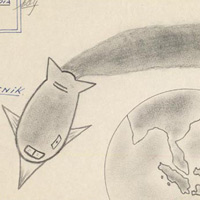 |

13歲峇裡男孩所繪的「史普尼克號」(Sputniki)
,1957

|
 |
|
 |
米德與科技
米德相信二次世界大戰後,世界變化的速度比從前快上許多。促成核子彈、電視及太空旅行的科技發展迅速。因而致導成人無法完全跟上變化的腳步,但米德認為小孩能輕而易舉的調適自己並追上日新月異的技術變化。她稱孩童為現代社會的「原住民」而成人則為「外來移民」。
米德透過社會研究技巧來研究她對改變的想法。1950及60年代時,她對美國、加拿大、
峇裡島(印尼的一部分)及馬奴斯島的小孩講述太空旅行及第一架環繞地球軌道運行的衛星「史普尼克號」 (Sputnik:1957年時,由前蘇聯發射進入太空);您認為她發現了什麼?
Mead believed that, after World War II, the world was changing much faster than ever before. Developments in science and technology, like nuclear bombs, television, and space travel, happened so quickly that adults couldn't really keep up, but Mead thought that kids could easily adapt to rapid technological change. She called children the "natives" and adults the "immigrants" of the modern world.
Mead used social science techniques to research her ideas about change. In the 1950s and '60s she talked to kids in the United States, Canada, Bali (part of Indonesia), and Manus about space travel and Sputnik, the first satellite to orbit the Earth (launched by the Soviet Union in 1957). What do you think she discovered?

 2 / 3 頁
2 / 3 頁

|





